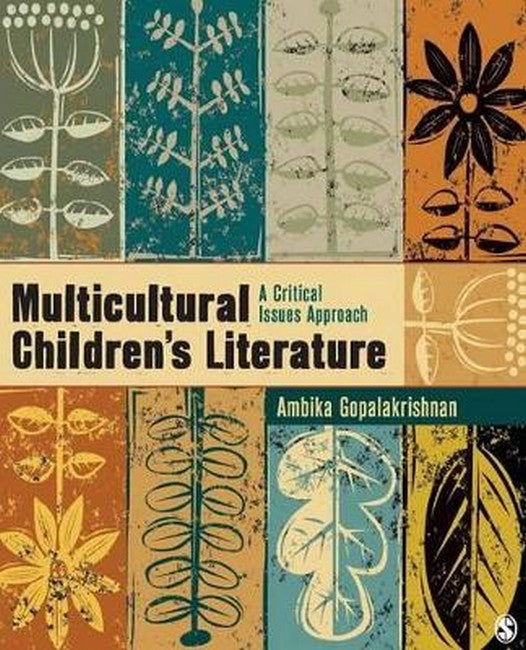Preface Part I: Taking a Critical Issues Approach 1. Introduction to Multicultural Children's Literature: A Critical Issues Approach Children's Literature Defined Multicultural Children's Literature A Brief Historical Overview Role of Multicultural Children's Literature in Today's Schools Critical Literacy and Multicultural Children's Literature Forming Issues Into and Through Critical Literacy Lessons Reflection Questions for the Teacher Sample Response Lesson 1.1: Forming a Critical Literacy Lesson Using Educational Drama Examples of Responses to Lesson 1.1 Selected Annotated Bibliography References 2. The Essentials and Foundations of Multicultural Children's Literature Tracing a Brief History of Multiculturalism Multiculturalism to Multicultural Children's Literature Multicultural Children's Literature and Levels of Multiculturalism Defining Multicultural Children's Literature The Need for Multicultural Children's Literature Conclusion Reflection Questions for the Teacher Sample Response Lesson 2.1: Check for Authenticity Selected Annotated Bibliography References 3. Choosing Books and Reading Critically Choosing Critical Children's Books Reader Response Reading Aloud and Transactional Theory Questioning As the Experts: Authors, Parents, Educators, and Teachers Reflection Questions for the Teacher Sample Response Lesson 3.1: Change Is Not Easy Example of Response to Lesson 3.1 Sample Response Lesson 3.2: Negotiating a Deal Selected Annotated Bibliography References Part II: Exploring Issues in Multicultural Children's Literature 4. Responding to Censorship, Book Banning, and Controversies What is Censorship? Intellectual Freedom and the First Amendment Why Are Books Censored? What Does Censorship Really Do? What do Authors, Publishers, Teachers, and Parents Say About Censorship? Useful Resources Reflection Questions for the Teacher Web Sites of Organizations Sample Response Lesson 4.1: Censorship Selected Annotated Bibliography References 5. Gender, Sexuality, and Equity Gender Roles Portrayed in Children's Literature Children's Reading Preferences Gender Equity and Finding a Balance Some Considerations and Recommendations Children's Books and Sexuality Sexuality Portrayed in Children's Books Using Children's Books to Promote Equity and Understanding Reflection Questions for the Teacher Sample Response Lesson 5.1: Gender Roles Sample Response Lesson 5.2: Gender and Coming of Age Selected Annotated Bibliography References 6. Understanding or Justifying Violence Defining Violence Justifying Violence in Children's Books Steps to Counter Violence in the Media Gang Violence Traditional Tales and Violence Real Life, History, and Violence Understanding Violence Reflection Questions for the Teacher Sample Response Lesson 6.1: Violence Sample Response Lesson 6.2: Violence Selected Annotated Bibliography References Part III: Realities in Life and Multicultural Children's Literature 7. War, Terrorism, Justice, and Freedom Making Meaning: A Historical Perspective Making Meaning: A Current Perspective Making Meaning and Critical Connections Using Children's Books to Address War, Terrorism, Justice, and Freedom Past Depictions Current Depictions Reading Authentic Accounts Finding Resilience in the Face of Adversity Conclusion Reflection Questions for the Teacher Sample Response Lesson 7.1: Exploring Issues of War Using Educational Drama Example of Responses to Lesson 7.1 Selected Annotated Bibliography References 8. Prejudice, Bullying, Abuse, and Other Challenging Situations Defining and Discussing Challenging Situations Prejudice Bullying Poverty Abuse Divorce Child Labor Reflection Questions for the Teacher Sample Response Lesson 8.1: Poverty Sample Response Lesson 8.2: Foster Care Selected Annotated Bibliography References 9. Disabilities and the Special Child The Need for Representating Disabilities and Special Needs in Classrooms The Special Child Disabilities as a 'Multicultural' Group Children Who Are Health Impaired Reflection Questions for the Teacher Sample Response Lesson 9.1: Children With Special Needs Sample Response Lesson 9.2: Children With Special Needs Selected Annotate Bibliography References 10. Influences of a Digital World The Internet, Television, and the Video Industry Digital Age Literature Computer Books and Programs Audiobooks Reflection Questions for the Teacher Sample Response Lesson 10.1: http://www.tumblebooks.com Sample Response Lesson 10.2: http://www.en.childrenlibrary.org Selected Annotated Bibliography References Glossary Index About the Author About the Contributing Author

